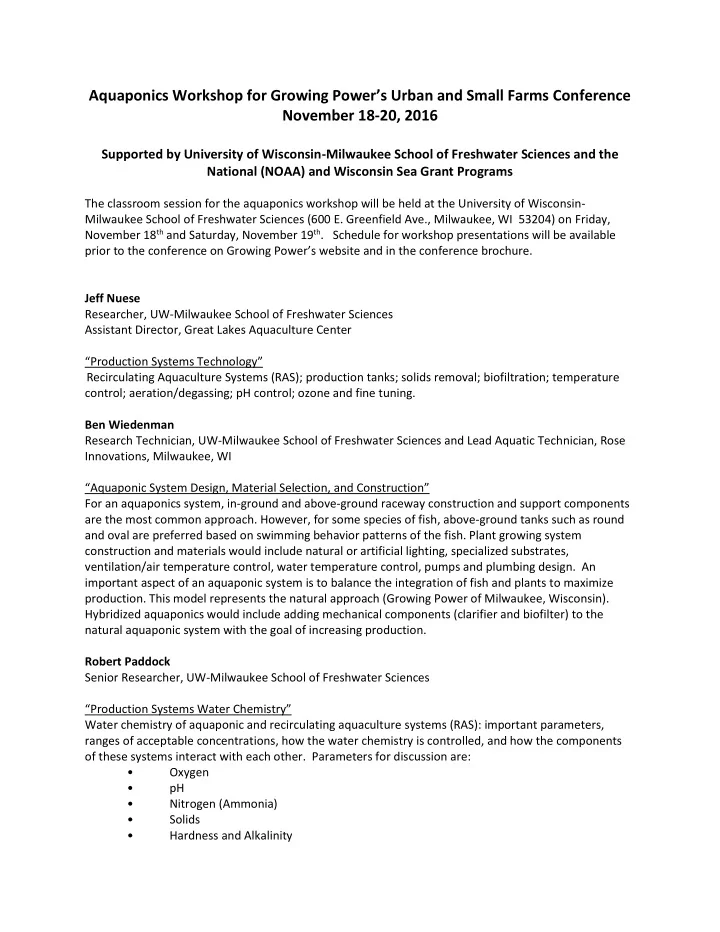

Aquaponics Workshop for Growing Power’s Urban and Small Farms Conference November 18-20, 2016 Supported by University of Wisconsin-Milwaukee School of Freshwater Sciences and the National (NOAA) and Wisconsin Sea Grant Programs The classroom session for the aquaponics workshop will be held at the University of Wisconsin- Milwaukee School of Freshwater Sciences (600 E. Greenfield Ave., Milwaukee, WI 53204) on Friday, November 18 th and Saturday, November 19 th . Schedule for workshop presentations will be available prior to the conference on Growing Power’s website and in the conference brochure. Jeff Nuese Researcher, UW-Milwaukee School of Freshwater Sciences Assistant Director, Great Lakes Aquaculture Center “Production Systems Technology” Recirculating Aquaculture Systems (RAS); production tanks; solids removal; biofiltration; temperature control; aeration/degassing; pH control; ozone and fine tuning. Ben Wiedenman Research Technician, UW-Milwaukee School of Freshwater Sciences and Lead Aquatic Technician, Rose Innovations, Milwaukee, WI “Aquaponic System Design, Material Selection, and Construction” For an aquaponics system, in-ground and above-ground raceway construction and support components are the most common approach. However, for some species of fish, above-ground tanks such as round and oval are preferred based on swimming behavior patterns of the fish. Plant growing system construction and materials would include natural or artificial lighting, specialized substrates, ventilation/air temperature control, water temperature control, pumps and plumbing design. An important aspect of an aquaponic system is to balance the integration of fish and plants to maximize production. This model represents the natural approach (Growing Power of Milwaukee, Wisconsin). Hybridized aquaponics would include adding mechanical components (clarifier and biofilter) to the natural aquaponic system with the goal of increasing production. Robert Paddock Senior Researcher, UW-Milwaukee School of Freshwater Sciences “Production Systems Water Chemistry” Water chemistry of aquaponic and recirculating aquaculture systems (RAS): important parameters, ranges of acceptable concentrations, how the water chemistry is controlled, and how the components of these systems interact with each other. Parameters for discussion are: • Oxygen • pH • Nitrogen (Ammonia) • Solids • Hardness and Alkalinity
Ryan Newton Professor, UWM School of Freshwater Sciences “Aquatic Microbiology” Nitrifying Microorganisms Substrates Bacteria life history (environmental requirements) Important water chemistry parameters: pH, oxygen, NH 3 , NO 2 , NO 3 , CO 2 , hardness, alkalinity. Monitoring and measuring instrumentation Analysis Upper and lower limits related to aquatic organisms and optimal conditions. Commonly occurring fish pathogens Diseases prevention/biosecurity Fred Binkowski Director, Great Lakes Aquaculture Center Senior Scientist, UW-Milwaukee School of Freshwater Sciences “Fin Fish Biology” Adopting the Vertically Integrated Approach ”: Broodstock development; artificial fertilization; egg incubation; early life stage culture (physical, biological and chemical requirements); fingerling production; production to market size; and monitoring production (growth, condition factor, food conversion). Jerry Kaster Associate Professor, UW-Milwaukee School of Freshwater Sciences “Shellfish Biology” Basic biology and culture techniques for native crayfish, Australian crayfish, freshwater prawns, and others. Basic structure of invertebrate husbandry, technology used to rear invertebrates including reproduction, early-life history, juvenile production, nursery, and grow-out systems. The Red Claw Crayfish (Cherax quadricarnatus) will be used to illustrate production management from aquaponic culture to table. Jessie Grow Research Specialist, UW-Milwaukee School of Freshwater Sciences “ Aquaponic Horticulture; Botany for Beginners & Plant Husbandry Techniques” Growing plants in an aquaponic setting brings about new and unique components to consider, beyond the traditional soil-based growing methods. In this discussion, we'll cover basic plant husbandry and how it specifically relates to this delicately balanced system of fish, plants, and microbes. Topics will include nutritional requirements and availability, deficiency/toxicity issues, supplemental lighting options, common pest/disease identification, integrated pest management techniques, companion planting, and succession planting.
Dong-Fang Deng Fish Nutritionist and Senior Scientist, UWM-School of Freshwater Sciences “Aquatic Feed Nutrition and Feeding Management” Optimal feed management is key to a profitable aquaculture operation because feed cost usually accounts for 40-60% of production costs in aquaculture. This presentation will provide general discussions on 1) Managing feed to maintain its quality and shelf life; 2) Nutritional and physical criteria of optimal feed for a targeted species; 3) feeding for maximum growth and minimum waste production. Allyn Spears Research Microbiologist, USDA-Agriculture Research Service “Biosecurity and Fish Health in Aquaculture” General hygiene for practical biosecurity; types and sources of potential microbial disease risks; disease symptoms; diagnostic and treatment options; case studies. Christopher “Topher” Jacobso n Owner/Operator of PepperBoy Farms, New Ulm, Minnesota “Freshwater Fish as Raw Material for Processing” Seafood HACCP regulation and requirements; nutritive value of freshwater fish; establishments and production demands for freshwater fish processing (plant location, buildings and layout, personal hygiene, cleaning and disinfection in processing plant); processing equipment (chilling, freezing, smoking, packaging, labeling, etc.); marketing practices.
Recommend
More recommend